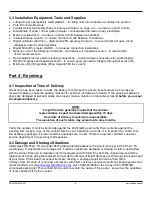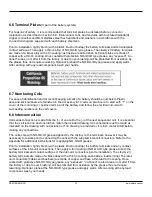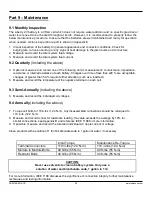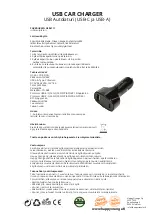
RS02109/0814/CD
13
www.cdtechno.com
The top row of connectors is to be installed first, then the second row down and so on, working from the
top down. When installing connectors, install the top (upper most) bolt first. Complete connector installation
by torquing all connections to 110 in-lb. [12.4 N-m], using an insulated torque-wrench.
NOTE:
Over-torquing can damage the post seal
and degrade connection integrity.
After torquing all connections and with the battery still on open circuit (not connected to the charging
source), take post-to-post resistance measurements. Start at one end of the string and work to the other
end, recording micro-ohm resistance of each inter-cell connection between cells. Clean and re-torque
connections (see Appendix B) of similar size connectors which exceed ±10% percent of the average resistance
of battery connections or five micro-ohms, whichever is greater.
IMPORTANT:
Record and retain the resistance readings with the
initial charge information for future reference. See Appendix E.
CAUTION:
It is the sole responsibility of the user to check connections.
Never operate a battery with loose or corroded connections.
When checking connections, disconnect the battery from the load and the charging equipment
and follow all the precautionary measures outlined above and in the general safety references.
Some resistance measurement equipment may cause a spark when the probes are applied to the
cell posts. Use appropriate safety precautions when conducting this measurement.
Typical cell and connection resistance values are provided in the Appendix according to cell type. In
addition, a listing of short circuit current in amperes is provided to further inform the user of the potential energy
available from these batteries.
After connecting all cells of the battery, check the battery voltage using a calibrated digital DC
voltmeter with at least three digits and 0.25% accuracy minimum. Battery voltage should equal
the open circuit voltage of an individual cell multiplied by the number of cells in the battery.
Example: (24 cells) x (2.16 VPC) = 51.84 OCV. If the OCV does not equal the expected value, inspect the
sequence of (+) to (-) connections. Further investigation may require re-inspecting each cell voltage
to confirm an acceptable value.
6.9 Tap Connections
Tap connections may electrically unbalance the battery system and
may
void the warranty.
If a
center tap is used, each side must have its own charging unit.
Содержание Liberty DCS
Страница 1: ...RS02109 0814 CD 1 www cdtechno com MSE DCS...
Страница 36: ...RS02109 0814 CD 36 www cdtechno com...
Страница 37: ...RS02109 0814 CD 37 www cdtechno com...














































